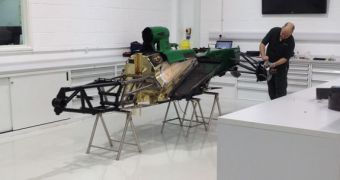3D printing technology has made great strides in the automotive market, with an entire car frame being created in a single go and, now, formula one racing car parts being manufactured through this method.
That's right, while the turtle-shaped 3D printed car (well, car body) is a nice enough invention, it is just one of a kind, and will stay that way for a while.
In the meantime, those that make cars, regardless of type, are stuck trying to incorporate 3D printing in their existing manufacture and assembly techniques.
An example really close to home (or far away from home depending on your view) is Renault, and their Renault V6 RS34 engine.
Well, technically the Caterham CT05 formula one racing car is the actual example, featuring a bodywork made of carbon fiber and epoxy resin.
The framework of the car is the result of months of research and testing conducted by engineers prior to the Formula One racing season in a modest factory building in Oxfordshire.
It took a while to match the 3D printing technology and the resulting parts to the goals of the design team.
After all, the car bodywork needed to slice through the air at maximum efficiency, otherwise that 18,000 rpm and 950 bhp (brake horsepower) would have gone to waste.
They did it though, making 3D printed parts that allowed the cars to meet the standards of F1 racing: accelerating to 100 mph in less than five seconds, and going from 100 to 0 mph in the same span of time.
Cornering ability is critical as well; otherwise, the frequency of derailing incidents and other accidents would be much greater. Or, preferably, the racing speed would be much lower, for safety reasons.
Ian Prince, Rapid Prototyping Manager for Caterham, says that they are making between 800 and 900 parts a month now.
For those unaware, Caterham is an F1 team originating from Malaysia but with operations based in the United Kingdom (UK).
Other teams like Infinity Red Bull are also using 3D printing technology to make some metal parts for their racing cars.
Not surprising, since every advantage is needed to win the Grand Prix. In about five years, 3D printing should be the main means through which racing cars, or at least car bodies, are made around the world. The normal car market shouldn't be too far off by that point either. And to think that, less than a year ago, there weren't any actual metal 3D printers out there.

 14 DAY TRIAL //
14 DAY TRIAL //